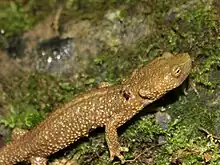| Calotriton | |
|---|---|
 | |
| Pyrenean brook newt (Calotriton asper) | |
| Scientific classification | |
| Domain: | Eukaryota |
| Kingdom: | Animalia |
| Phylum: | Chordata |
| Class: | Amphibia |
| Order: | Urodela |
| Family: | Salamandridae |
| Subfamily: | Pleurodelinae |
| Genus: | Calotriton Gray, 1858 |
| Type species | |
| Hemitriton punctulatus Dugès, 1852 | |
| Diversity | |
| 2 species (see text) | |
Calotriton, or the European brook newts, is a genus of newts native to the Pyrenees and central Catalonia (Catalan Pre-coastal Range). These amphibians were formerly placed within genus Euproctus, but the genus was resurrected in 2005. Instead of Euproctus, they seem more closely related to Triturus, their sister taxon.[1][2]
Evolution
Calotriton and Triturus are estimated to have split approximately 8 myr ago. This may have been associated with adaptation to fast-running, well-oxygenated mountain streams (instead of ponds in Triturus), leading to some superficial similarity with Euproctus in convergent evolution: strongly depressed head and body, and reduction or even absence of lungs.[3]
Description
Calotriton are small- to medium-sized newts, 70–167 mm (2.8–6.6 in) in total length. Skin is covered with tubercles bearing horny tips, more so above than beneath, which can be completely smooth. Limbs are moderate, with four fingers and five toes. Body is rounded or slightly depressed. There is no cutaneous dorsal and caudal crest, not even during the breeding season. Tail is about as long as head and body and compressed from side; longer in females and deeper in males. Lungs are absent or very reduced.[3]
Species
| Image | Scientific name | Common Name | Distribution |
|---|---|---|---|
 | Calotriton arnoldi Carranza & Amat, 2005 | Montseny brook newt | Montseny Massif (Catalan Pre-Coastal Range) in northeast Spain |
 | Calotriton asper (Dugès, 1852) | Pyrenean brook newt (formerly Euproctus asper) | the Pyrenees of Andorra, France, and Spain |
References
- 1 2 Frost, Darrel R. (2014). "Calotriton Gray, 1858". Amphibian Species of the World: an Online Reference. Version 6.0. American Museum of Natural History. Retrieved 9 March 2015.
- ↑ Gray, J.E. (1858). "Proposal to separate the family of salamandridae, Gray, into two families, according to the form of the skull". Proceedings of the Zoological Society of London. 26: 136–144. doi:10.1111/j.1469-7998.1858.tb06357.x.
- 1 2 Carranza, S.; Amat, F. (2005). "Taxonomy, biogeography and evolution of Euproctus (Amphibia: Salamandridae), with the resurrection of the genus Calotriton and the description of a new endemic species from the Iberian Peninsula". Zoological Journal of the Linnean Society. 145 (4): 555–582. doi:10.1111/j.1096-3642.2005.00197.x.
- ↑ "Salamandridae". AmphibiaWeb: Information on amphibian biology and conservation. [web application]. Berkeley, California: AmphibiaWeb. 2015. Archived from the original on 15 April 2019. Retrieved 9 March 2015.
- Andreas Nöllert & Christel Nöllert: Die Amphibien Europas. – Franckh-Kosmos, Stuttgart, 1992. ISBN 3-440-06340-2
External links
![]() Media related to Calotriton at Wikimedia Commons
Media related to Calotriton at Wikimedia Commons